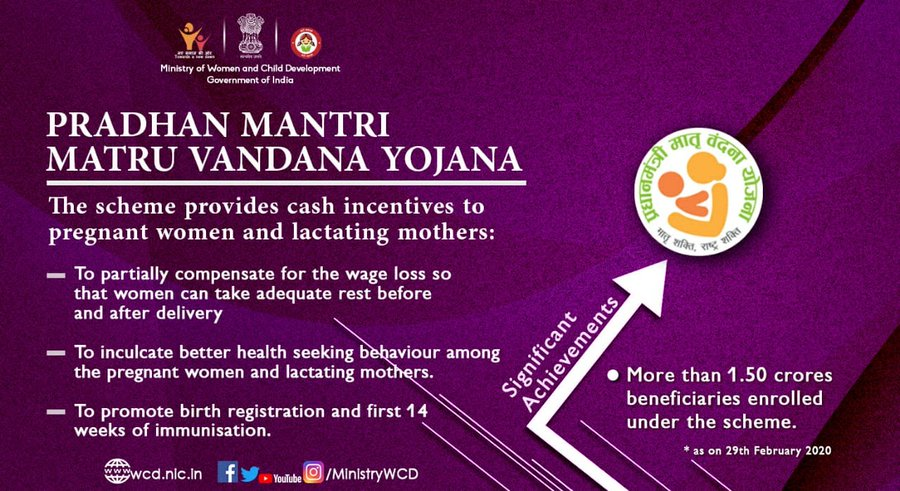Description

Copyright infringement is not intended
Context: The Ministry of Women and Child Development presented the details on the implementation of Pradhan Mantri Matru Vandana Yojana in the Lok Sabha.
Details
- The Pradhan Mantri Matru Vandana Yojana (PMMVY) is a Centrally Sponsored Direct Benefit Transfer (DBT) scheme.
- The scheme is implemented transparently and efficiently through web-based Management Information System (MIS) Software, viz. Pradhan Mantri Matru Vandana Yojana-Common Application Software (PMMVY-CAS).
About Pradhanmantri Matru Vandana Yojana
- The Prime Minister announced the scheme in 2016.
- Implementing body: Ministry of Women and Child Development
- Under the scheme, a woman gets Conditional government support of ₹5,000 in three installments for first living child.
- Beneficiaries - Women not working under Central or State governments or a Public Sector Undertaking and they don't receive any similar benefits under any law are eligible to get benefits under the Scheme.
- Beneficiaries get Monetary benefit in Three instalments on fulfilling the respective conditions:
- Early registration of pregnancy
- Ante-natal check-up and registration of the birth of the child
- Completion of the first cycle of vaccination for the child.
- To get benefits under the scheme, the women must be 19 years of age or more at the time of pregnancy.
- Janani Suraksha Yojana that provides monetary benefit of ₹1,000 for institutional births is linked with Pradhanmantri Matru Vandana Yojana. Thus a mother gets an average of ₹6,000 under maternity benefit programmes.
- The government provides monetary support as the partial wage compensation, so that she can get proper nutrition during her pregnancy.
- Monetary benefit provided to pregnant women through direct benefit transfer (DBT) in their bank account directly.
Concerns
- Some activists criticise the scheme for under-funding and Failing to cover all targeted beneficiaries.
- Some activists also call the scheme illegal as it violates the National Food Security Act, 2013 under which all mothers, and not just mothers of the first living child, should get a maternity benefit of ₹6,000.
- Lack of awareness among pregnant women, Lengthy registration process.
- The requirement to produce the husband’s Aadhar card results in excluding women who may be living with men and are not married to, single mothers and those who may be staying at their parents home.
- Women must also have the address of their marital home on their Aadhar card, which often results in newlyweds being either left out or forced to go from door-to-door when pregnant and needing rest and care.
- Delays in transferring the cash amount to the beneficiaries.
- Low monetary benefit, therefore most women continue to work during and post-pregnancy since they cannot afford to lose wages.
Steps taken by the Government
- Janani Suraksha Yojana (JSY) under the National Health Mission (NHM), promoting institutional delivery. For home delivery, monetary benefit to only BPL pregnant women.
- Janani Shishu Suraksha Karyakram (JSSK) entitles all pregnant women delivering in public health institutions to have absolutely free and no expense delivery, including caesarean section.
- Pradhan Mantri Surakshit Matritva Abhiyan (PMSMA) provides pregnant women free of cost assured and quality Antenatal Care on the 9th day of every month.
- Surakshit Matratva Ashwasan (SUMAN) aims to provide quality healthcare at no cost and zero tolerance for denial of services for every woman and newborn visiting the public health facility.
- LaQshya aims to improve the quality of care in the Labour room and Maternity operation.
- Mission Shakti has been launched recently to provide integrated benefits of safety, security and empowerment to women.
- Under the revamped Pradhanmantri Matru Vandana Yojana under Mission Shakti, written consent and the Aadhar of husband is not a mandatory criterion, and this change will make the scheme more inclusive for single and abandoned mothers.
- The maternity benefit amounting to Rs.6,000/- is also to be provided for the second child, but only if the second child is a girl child, to discourage pre-birth sex selection and to promote the girl child.
- Samarthya is an integrated sub-scheme under Mission Shakti for empowerment of women which includes Ujjawala, Swadhar Greh, Working Women Hostel, and National Crèche Scheme for Children of Working Mothers and PMMVY.
- Specific allocation is made for each component of Samarthya.
- Sufficient budgetary provision has been made under Samarthya for implementation of PMMVY.
Way Forward
- Need to extend the benefit under the scheme to the second child, specially when the second child is a girl, this would ensure socio-economic development of women and Child, and also promote women empowerment.
- The Odisha model - Odisha has its own State-sponsored scheme called ‘Mamata’ that includes two births.
- Need to increase the maternity benefit amount as the primary objective of the scheme is to provide partial wage compensation.
- Pay greater attention to the special needs of pregnancy: good nutrition and health care.
- Simplify the process, Create awareness within targeted beneficiaries; A simplification of the process can result in increased registration of beneficiaries.
https://www.pib.gov.in/PressReleasePage.aspx?PRID=1809690












